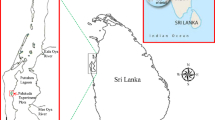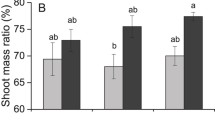Abstract
In analysing the global decline of macrophytes, a scant attention was generally paid to the direct relations of rooted aquatic plants with sediment eutrophication. Nevertheless, the sediment is a pivotal driver of macrophyte dynamics. In order to add new data about aquatic plant–sediment interactions, a microcosm experiment was performed to gain knowledge on the growth dynamics of the rare aquatic fern Marsilea quadrifolia L. Healthy shoots of M. quadrifolia were grown under an increasing availability of nutrients (N and P) and reducing sediment conditions for a total incubation time of 42 days. The variation in biomass and number of fronds and knots was monitored regularly at intervals of 10–11 days. The results confirm the pivotal role of sediment in driving the growth of M. quadrifolia, which responds rapidly to the increase in nutrient availability up to a moderate excess. M. quadrifolia seems to be a slightly eutrophic-rooted aquatic species, able to tolerate pore-water concentrations up to ~450 and 4 μM of NH4 + and PO4 3−, respectively. The present data corroborate the need to consider the short-term dynamics when analysing plant adaptations to sediment eutrophication, as well as a physical and chemical characterization of sediments to evaluate their potential bioreceptivity.





Similar content being viewed by others
References
Aspila, K. I., H. Agemian & A. S. Y. Chau, 1976. A semi-automated method for the determination of inorganic, organic and total phosphate in sediments. Analyst 101: 187–197.
Bakker, E. S., J. M. Sarneel, R. D. Gulati, Z. Liu & E. van Donk, 2013. Restoring macrophyte diversity in shallow temperate lakes: biotic versus abiotic constraints. Hydrobiologia 710: 23–37.
Barko, J. W. & R. M. Smart, 1986. Sediment-related mechanisms of growth limitation in submerged macrophytes. Ecology 65: 1328–1340.
Bolpagni, R. & A. Piotti, 2015a. Hydro-hygrophilous vegetation diversity and distribution patterns in riverine wetlands in an agricultural landscape: a case study from the Oglio River (Po Plain, Northern Italy). Phytocoenologia 45: 69–84.
Bolpagni, R. & A. Piotti, 2015b. The importance of being natural in a human-altered riverscape: Role of wetland type in supporting habitat heterogeneity and the functional diversity of vegetation. Aquatic Conservation: Marine and Freshwater Ecosystems. doi:10.1002/aqc.2604.
Bolpagni, R., M. Bartoli & P. Viaroli, 2013. Species and functional plant diversity in a heavily impacted riverscape: implications for threatened hydro-hygrophilous flora conservation. Limnologica 43: 230–238.
Bolpagni, R., A. Laini, E. Soana, M. Tomaselli & J. Nascimbene, 2015. Growth performance of Vallisneria spiralis under oligotrophic conditions supports its potential invasiveness in mid-elevation freshwaters. Weed Research 55: 185–194.
Bornette, G. & S. Puijalon, 2011. Response of aquatic plants to abiotic factors: a review. Aquatic Sciences 73: 1–14.
Boustany, R. G., T. C. Michot & R. F. Moss, 2010. Effects of salinity and light on biomass and growth of Vallisneria americana from Lower St. Johns River, FL, USA. Wetlands Ecology and Management 18: 203–217.
Bower, C. F. & T. T. Holm-Hansen, 1980. A salicylate-hypochlorite method for determining ammonia in seawater. Canadian Journal of Fisheries and Aquatic Sciences 37: 794–798.
Brouwer, E. & J. G. M. Roelofs, 2001. Degraded softwater lakes: possibilities for restoration. Restoration Ecology 9: 155–166.
Bruni, I., R. Gentili, F. De Mattia, P. Cortis, G. Rossi & M. Labra, 2013. A multi-level analysis to evaluate the extinction risk of and conservation strategy for the aquatic fern Marsilea quadrifolia L. in Europe. Aquatic Botany 111: 35–42.
Cai, X., L. Yao, G. Gao, Y. Xie, J. Yang, X. Tang & M. Zhang, 2016. Responses in root physiological characteristics of Vallisneria natans (Hydrocharitaceae) to increasing nutrient loadings. Knowledge and Management of Aquatic Ecosystems 417: 4.
Drava, G., E. Roccotiello, V. Minganti, A. Manfredi & L. Cornara, 2012. Effects of cadmium and arsenic on Pteris vittata under hydroponic conditions. Environmental Toxicology and Chemistry 31: 1375–1380.
Gulati, R. D., L. M. D. Pires & E. van Donk, 2008. Lake restoration studies: Failures, bottlenecks and prospects of new eco-technological measures. Limnologica 38: 233–247.
Guillitte, O., 1995. Bioreceptivity: a new concept for building ecology studies. Science of the Total Environment 167: 215–220.
Hodge, A., 2004. The plastic plant: root responses to heterogeneous supplies of nutrients. New Phytologist 16: 24–29.
Hoffmann, M., U. Reader & A. Melzer, 2015. Influence of environmental conditions on the regenerative capacity and the survivability of Elodea nuttallii fragments. Journal of Limnology 74: 12–20.
Husák, S. & H. Oťaheľová, 1986. Contribution to the ecology of Marsilea quadrifolia L. Folia Geobotanica et Phytotaxonomica 21: 86–89.
Hussner, A., T. Mettler-Altmann, A. P. M. Weber & K. Sand-Jensen, 2016. Acclimation of photosynthesis to supersaturated CO2 in aquatic plant bicarbonate users. Freshwater Biology. doi:10.1111/fwb.12812.
Lenth, R., 2015. lsmeans: least-squares means. R package version 2.20-23. http://CRAN.R-project.org/package=lsmeans.
Keruzoré, A. A., N. J. Willby & D. J. Gilvear, 2013. The role of lateral connectivity in the maintenance of macrophyte diversity and production in large rivers. Aquatic Conservation: Marine and Freshwater Ecosystems 23: 301–315.
Kozlowski, G. & S. Vallelian, 2009. Eutrophication and endangered aquatic plants: An experimental study on Baldellia ranunculoides (L.) parl. (Alismataceae). Hydrobiologia 635: 181–187.
Mascaró, O., T. Valdemarsen, M. Holmer, M. Pérez & J. Romero, 2009. Experimental manipulation of sediment organic content and water column aeration reduces Zostera marina (eelgrass) growth and survival. Journal of Experimental Marine Biology and Ecology 373: 26–34.
Nienhuis, P. H., J. P. Bakker, A. P. Grootjans, R. D. Gulati & V. N. De Jonge, 2002. The state of the art of aquatic and semi-aquatic ecological restoration projects in the Netherlands. Hydrobiologia 478: 219–233.
Pierobon, E., R. Bolpagni, M. Bartoli & P. Viaroli, 2010. Net primary production and seasonal CO2 and CH4 fluxes in a Trapa natans L. meadow. Journal of Limnology 69: 225–234.
Pinardi, M., M. Bartoli, D. Longhi, U. Marzocchi, A. Laini, C. Ribaudo & P. Viaroli, 2009. Benthic metabolism and denitrification in a river reach: a comparison between vegetated and bare sediments. Journal of Limnology 68: 133–145.
Pinheiro, J., D. Bates, S. DebRoy, D. Sarkar & R Core Team, 2016. Nlme: linear and nonlinear mixed effects models. R package version 3.1-126, http://CRAN.R-project.org/package=nlme.
Pulido, C., E. C. H. E. T. Lucassen, O. Pedersen & J. G. M. Roelofs, 2011. Influence of quantity and lability of sediment organic matter on the biomass of two isoetids, Littorella uniflora and Echinodorus repens. Freshwater Biology 56: 939–951.
Pulido, C., J. L. Riera, E. Ballestreros, E. Chappuis & E. Gacia, 2015. Predicting aquatic macrophyte occurrence in soft-water oligotrophic lakes (Pyrenees mountain range). Journal of Limnology 74: 143–154.
R Development Core Team, 2015. A language and environment for statistical computing. R Foundation for Statistical Computing, Wien.
Raun, A. L., J. Borum & K. Sand-Jensen, 2010. Influence of sediment organic enrichment and water alkalinity on growth of aquatic isoetid and elodeid plants. Freshwater Biology 55: 1891–1904.
Ribaudo, C., M. Bartoli, E. Racchetti, D. Longhi & P. Viaroli, 2011. Seasonal fluxes of O2, DIC and CH4 in sediments with Vallisneria spiralis: indications for radial oxygen loss. Aquatic Botany 94: 134–142.
Sand-Jensen, K., 1997. Macrophytes as biological engineers in the ecology of Danish streams. In Sand-Jensen, K. & O. Pedersen (eds), Freshwater biology: priorities and development in Danish research. Gad Publisher, København: 74–101.
Sand-Jensen, K. & C. L. Møller, 2015. Reduced root anchorage of freshwater plants in sandy sediments enriched with fine organic matter. Freshwater Biology 59: 427–437.
Sand-Jensen, K., C. Prahl & H. Stokholm, 1982. Oxygen release from roots of submerged aquatic macrophytes. Oikos 38: 349–354.
Sand-Jensen, K., C. L. Møller & J. Borum, 2015. High resistance of oligotrophic isoetid plants to oxic and anoxic dark exposure. Freshwater Biology 60: 1044–1051.
Scheffer, M., S. Szabo, A. Gragnani, E. H. Van Nees, S. Rinaldi, N. Kautsky, J. Norberg, R. M. Roijackers & R. J. Franken, 2003. Floating plant dominance as a stable state. Proceedings of the National Academy of Sciences 100: 4040–4045.
Schneider, B., E. R. Cunha, M. Marchese & S. M. Thomaz, 2015. Explanatory variables associated with diversity and composition of aquatic macrophytes in a large subtropical river floodplain. Aquatic Botany 121: 67–75.
Shields, E. C. & K. A. Moore, 2016. Effects of sediment and salinity on the growth and competitive abilities of three submersed macrophytes. Aquatic Botany 132: 24–29.
Silveira, M. J. & S. M. Thomaz, 2015. Growth of a native versus an invasive submerged aquatic macrophyte differs in relation to mud and organic matter concentrations in sediment. Aquatic Botany 124: 85–91.
Silveira, M. J., V. C. Harthman, T. S. Michelan & L. A. Souza, 2016. Anatomical development of roots of native and non-native submerged aquatic macrophytes in different sediment types. Aquatic Botany 133: 24–27.
Smolders, A. P. J., E. C. H. E. T. Lucassen & J. G. M. Roelofs, 2002. The isoetid environment biogeochemistry and threats. Aquatic Botany 73: 325–350.
Soana, E. 2013. Radial oxygen loss from roots of Vallisneria spiralis L.: biogeochemical implications in eutrophic aquatic ecosystems. Parma: PhD thesis.
Soana, E. & M. Bartoli, 2013. Seasonal variation of radial oxygen loss in Vallisneria spiralis L.: an adaptation to sediment redox? Aquatic Botany 104: 228–232.
Soana, E. & M. Bartoli, 2014. Seasonal regulation of nitrification in a rooted macrophyte (Vallisneria spiralis L.) meadow under eutrophic conditions. Aquatic Ecology 48: 11–21.
Soana, E., M. Naldi & M. Bartoli, 2012. Effects of increasing organic matter loads on pore-water features of vegetated (Vallisneria spiralis L.) and plant-free sediments. Ecological Engineering 47: 141–145.
Søndergaard, M., E. Jeppesen, T. L. Lauridsen, C. Skov, E. H. Van Nees, R. Roijackers, E. Lammens & R. Portielje, 2007. Lake restoration: successes, failures and long-term effects. Journal of Applied Ecology 44: 1095–1105.
Stehlik, I., J. P. Caspersen, L. Wirth & R. Holderegger, 2007. Floral free fall in the Swiss lowlands: Environmental determinants of local plant extinction in a peri-urban landscape. Journal of Ecology 95: 734–744.
Valdemarsen, T., E. Kristensen & M. Holmer, 2009. Metabolic threshold and sulphide-buffering in diffusion controlled marine sediments impacted by continuous organic enrichment. Biogeochemistry 95: 335–353.
Valderrama, J. C., 1977. Methods used by the hydrographic Department of the National Board of Fisheries, Sweden. In Grasshof, K. (ed.), Report of the Baltic intercalibration workshop. Interim Commission for the Protection of the Environment of the Baltic Sea, Goteborg: 13–40.
Wang, J. & D. Yu, 2007. Influence of sediment fertility on morphological variability of Vallisneria spiralis L. Aquatic Botany 122: 94–99.
Xiao, K., D. Yu & J. Wang, 2006. Habitat selection in spatially heterogeneous environments: A test of foraging behaviour in the clonal submerged macrophyte Vallisneria spiralis. Freshwater Biology 51: 1552–1559.
Yuan, G., H. Fu, J. Zhong, Q. Lou, L. Ni & T. Cao, 2016. Growth and C/N metabolism of three submersed macrophytes in response to water depths. Environmental and Experimental Botany 68: 44–50.
Zhang, M., T. Cao, L. Ni, P. Xie & Z. Li, 2010. Carbon, nitrogen and antioxidant enzyme responses of Potamogeton crispus to both low light and high nutrient stresses. Environmental and Experimental Botany 68: 44–50.
Acknowledgements
We would like to thank Dr. E. Soana and Dr. M. Bartoli for their suggestions on and contributions to the experiment design. Special thanks goes to Prof. P. Viaroli for his valuable comments on an early version of the present manuscript. We also express our gratitude to Dr. A. Laini for his fundamental support in the statistical analyses. We thank the Parchi del Ducato and Dr. N. Toscani for the field support. We thank the Associate editor and three anonymous reviewers for their excellent comments on the draft of this article. Dr. R. Bolpagni was partially supported by the University of Parma (Grant No. 377-03102014).
Author information
Authors and Affiliations
Corresponding author
Additional information
Handling editor: André Padial
Electronic supplementary material
Below is the link to the electronic supplementary material.
10750_2016_3064_MOESM2_ESM.tif
Supplementary material 2 (TIFF 388 kb). Illustrative images of two shoots of Marsilea quadrifolia showing fronds and knots
Rights and permissions
About this article
Cite this article
Bolpagni, R., Pino, F. Sediment nutrient drivers of the growth dynamics of the rare fern Marsilea quadrifolia . Hydrobiologia 792, 303–314 (2017). https://doi.org/10.1007/s10750-016-3064-4
Received:
Revised:
Accepted:
Published:
Issue Date:
DOI: https://doi.org/10.1007/s10750-016-3064-4




